How to Trim a Dog’s Nails
When you think about grooming a dog, you probably consider bathing him, brushing his coat, even cleaning those floppy ears, but its a good idea to give dogs a pedicure every few weeks as well. If youve never trimmed a dogs nails, ask for some help from a more experienced person, and keep these instructions nearby.
1: Stay Sharp
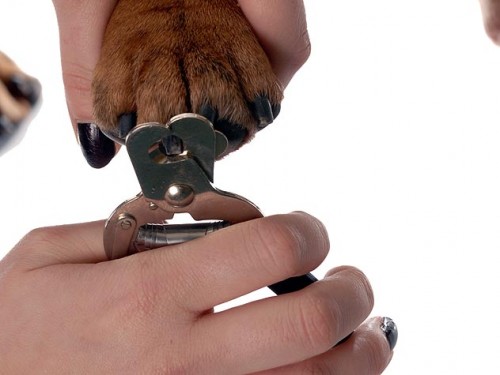
2: Pull Their Legs
Dogs are often pretty cooperative when it comes to having their nails trimmed, and those who were handled often as puppies are even more likely to comply. Still, you may need to work a little to keep the animal still. If youre working alone, have the dog sit or lie down on the floor or examining table, then trim the nails, one paw at a time.
3: Pull Their Legs, Part II
If youre grooming a larger dog or if the animal is apprehensive, have someone sit him down and hold out his paw, then get to work with the clippers. Have your helper scratch behind the dogs ears to reassure the animal and help move things along a little more quickly.
4: Take the Edge Off
Remember that you should only remove the very end of the dogs nails. You may be tempted to trim off all of the excess, but that would be a mistake. In dogs, the quickthe nerve endings and blood vessels inside the nailcontinue to grow as the nail grows. That means long nails must be trimmed bit by bit, over weeks or months, until the quick gradually recedes. Because its so difficult to see the quick in dogs with dark nails, youll need to look at the nail straight on (see diagram below)and keep trimming until you see a small dark circle. If you accidentally clip too far and the nail begins to bleed, apply pressure to the tip of the nail or dip the nail in a bit of styptic powder, then make sure the animal is kept inactive for a short time.
5: Thank Them Very Much
Give the dog a treat or a pat on the tummy to thank him for his cooperation, and things should go at least as well the next time around.
Great Children-Friendly Dog Breeds

Airedale Terrier
The “King of the Terriers” is hugely versatile, performing successfully as a hunter, guide dog for the blind, livestock herder, elegant show dog, and loving family pet. Airedale Terriers are smart, sensitive, and playful, making them fabulous companions for children. More>>
Australian Shepherd
Australian Shepherds are active, intelligent “people dogs” who want nothing more than to be a part of the family. Happy to travel to kids’ baseball games, join in on fun outings like trips to the beach, and herd the kids around the yard, Aussies make wonderful companions for respectful children who are taught to behave properly around the dog.
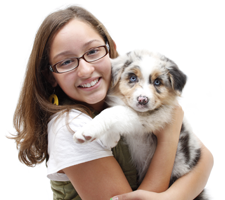
It’s hard to deny the Beagle’s rightful place in a fun-loving pack of “Peanuts,” though Beagles are more engaged and sincere than the ever-famous Snoopy and just as entertaining. This short-haired miniature hound loves to be a part of the family and to be involved in everyday things. He will follow little ones around the house and yard, keeping one eye on them and the other on mischief of his own. He needs a good parent to train him and teach him manners since he’s naturally a curious little fellow with big-dog ideas of his won.
Bearded Collie
Described as bouncy and exuberant—ideal for keeping happy kids active and moving— the Bearded Collie lives to be around children. With its long, easycare, unkempt coat and athletic build, the Beardie loves to participate in fun activities and sports, like jogging, running alongside a bicycle, hiking, and chasing sheep (get some!). The Bearded Collie’s strong sheepdog instincts can lead to its gathering (herding) young people or even nipping at their Nikes: parents must train the dog to know the difference between kids and ewes and supervise so that the dog’s nanny instincts are properly channeled.
Bernese Mountain Dog
For the family with children seeking a large dog, the Bernese Mountain Dog makes a docile, sweet-natured companion. With its long, silky black coat marked with characteristic white and rust, the Bernese stands up to 27.5 inches at the shoulder. It is a versatile outdoor dog whose smart and confident demeanor recommend it for the job of child’s companion. They are known to be able to do anything from pulling carts, herding cows, guarding the home, yard and farm, and even babysitting the kids.
Bichon Frise
This animated powder puff is a lovely companion for older children, and fits perfectly in any household, from suburban living to big-city apartments. The beautiful, plush, snow-white coat is low shedding dog breed but needs regular professional grooming to maintain. The Bichon Frise might be suitable for people with dog allergies.
Boston Terrier
Playful, gentle, and affectionate, the Boston Terrier makes a great pal. Sturdy enough to enjoy rough play, they want to be with you and are not backyard dogs. This compact, smart breed is easy to care for, requires minimal exercise, and does best when his humans show gentle leadership.

The handsome Boxer is as loyal and dignified as he is affectionate and energetic. When trained and socialized, Boxers are tireless and downright silly companions for youngsters. Supervise to make sure 50 to 85 pounds of Boxer don’t knock over your kids and their friends.
Bulldog
The lumbering, gentle Bulldog is both sturdy and slow—a great match for families with kids. Often referred to as the English Bulldog, this dignified dog breed is typically an even-tempered and agreeable fellow, and tends to form tight bonds with children.
Bullmastiff
Created using a blend of 60 percent Mastiff and 40 percent Bulldog, the powerful Bullmastiff combines the best of both dog breeds in a large, strong package. This dog breed is devoted to his family, adores children, and possesses a protective but mellow outlook, making the Bullmastiff one of the better extra-large breeds for city living.
Bull Terrier
Like all terriers, the Bull Terrier is active and full of personality, and this sometimes comical breed is especially ready for fun. This is a substantial dog, weighing up to 70 pounds, and can be headstrong like a stubborn child. But with positive training, socialization, and inclusion in family activities, the Bull Terrier thrives as a loving companion.
Cairn Terrier
An active and super bright little dog—the breed once followed the skipping Dorothy down the Yellow Brick Road—Cairn Terrier loves to be the center of attention…in real life and movies! They’ve been described as rugged and resourceful and do best as family dogs, provided they have a dog-smart parent to teach them right from wrong. Since they will chase small animals, like squirrels and chipmunks, they must always be on lead when not in a safely fenced area.
Cavalier King Charles Spaniel
Nicknamed the “Comforter Spaniel” by British royalty who favored the dog breed throughout history, today’s Cavalier makes a devoted pet for gentle children and does not require a castle to keep him happy. Cavaliers can adapt to a little exercise or a lot, and the beautiful, silky coat is easily maintained with regular brushing and combing, so no professional grooming is required.

Even though most kids today haven’t heard of Lassie, the Collieremains the proverbial children’s dog due to the breed’s instinctive protective nature and the intelligence of a ten year old child. Collies like to take walks and run in the backyard, but they adapt to the family’s lifestyle and can be happy in any size home. The rough Collie requires more grooming than the smooth coat, but it’s essentially amounts to just a few minutes a week.
Golden Retriever
The bright, smiling Golden Retriever is a medium-sized sporting dog, weighing in between 55 and 75 pounds, with a long, lustrous coat in various shades of “golden.” This breed has never met a stranger and views all youngsters as his designated playmates. The Golden is always ready for play, whether it’s galloping in the backyard, swimming on the beach, or hiking on a trail.
Labrador Retriever
Lead a Lab to water and it will retrieve all day: balls, sticks, and even children who happen to go for a swim. Whether black, chocolate or yellow, the Lab’s kid-friendly nature has helped make him the most popular dog breed in the United States. Patient and gentle by nature, the Lab excels in a home with respectful children, and craves regular play and exercise to channel his exuberance for life.
Newfoundland
A devoted family companion dog with a sweet and even temperament, the Newfoundland has proved himself reliable around kind, well-behaved children. Although kids should never be allowed to climb on top of or ride on the backs of these gentle giants, Newfies are robust and engaged playmates, and delight in hauling children around in carts.
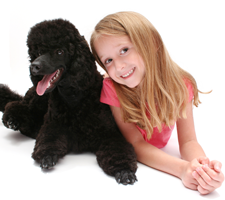
Although Toy Poodles are too fragile for young kids, Miniature Poodleand Standard Poodle are excellent playmates for respectful children. Well-bred Poodles are active and intelligent, and revel in learning fun tricks or playing endless games of fetch in the yard. An added bonus: Poodles are dogs that don’t shed and might be suitable for people with dog allergies.
Pug
The Pug is as sturdy and big as a Toy breed gets. Weighing in at 14 to 18 pounds, the Pug is a compact, little dog with tons of personality. Most Pugs are easygoing and playful, enjoying the attention of sensible children who recognize that the Pug is no plaything. In cool weather, Pugs are animated and entertaining friends for kids, but tire easier than larger dogs.
Weimaraner
No reason for the kids to be afraid of this ghost, the Weimaraner (called the “grey ghost” because of its distinct color) is an easygoing, tolerant family dog whose above-average intelligence makes him easy to train. Weims are naturally graceful and know how big they are, even if they attempt to snuggle with owners on small chairs on laps. Ancestors were bred to hunt, and today’s Weimaraner likes to be a member of the family pack.
Parsley Fresh-Breath Treats For Your Dog

Try these pup-pleasing, parsley dog treats!
Ingredients:
1¾ cup lukewarm meat or vegetable broth
1½ teaspoon dry yeast
1¾ cup all-purpose flour
1 cup whole wheat pastry flour
½ cup yellow cornmeal
¼ cup fat-free powdered milk
1 tablespoon fresh chopped parsley
Directions:
Preheat oven to 300 degrees
Dissolve yeast in lukewarm broth and let stand until foamy (about 10 minutes)
Stir in dry ingredients and fresh herbs
Roll the dough out to ¼-inch thickness
Cut shapes with your favorite cookie cutters, and bake on a greased cookie sheet for 45 minutes
Turn off oven, and allow biscuits to finish hardening 10 to 12 hours. Recipe makes 20 to 30 biscuits, depending on the size and shape.
Parsely and many other herbs can easily be grown in your home and can provide endless options for enriching your life and your dog’s.
Everything You Need to Know About Dog Bee Stings
Many of us have been stung by bees. No one likes it. When a bee comes by, people often flail and scream and run like Godzilla is attacking the city. Luckily a bee sting is generally not too bad. It might be a little painful and then it turns itchy, but that’s about it, unless of course you are allergic (in which case, please do run and scream).

Symptoms of an Allergic Reactions:
Swelling
Difficulty Breathing
General Weakness
To be safe, the ASPCA recommends taking a dog that has been stung be a bee to your vet for treatment right away, as significant allergic reactions can become life-threatening. This becomes even more important if your dog is stung by multiple bees or stung anywhere inside the mouth. Dogs, if stung multiple times at once, can suffer damage to their kidneys and even die from the complications.
Here are some tips on keeping your dog safe from bee stings:
1. Be smart when outdoors. Bees and wasps alike spend most of their time out and about during the hottest times of the day. Plan to take your dog on walks and have playtime at either dawn or dusk, as it reduces the risk of your pup being stung.
2. Stay away from flowers. Although, this might seem self explanatory for you, dogs might not understand. It is imperative to keep your dog away from flower gardens and the like because of the amount of bees that are usually found in those areas.
3. Light on the fragrances. Bees are attracted to sweet smells. So, if you are out and about with your dog, lay off the perfume and deodorant, as it might bring some unwelcome guests during playtime or your walk.
What if your dog is stung by a bee?
One important thing to always remember is to stay calm. Your best friend cannot be helped if you are not in the right state of mind.
Once you realize that your four-legged friend has been stung, take these steps to minimize the damage:
1. Look at the area where your dog was stung and try to remove the stinger if it is still present. Note: DO NOT try to pinch and pull it out like a splinter, as that can lead to more venom in the dog’s system. Instead, try to flick it out with your finger or a sharp edge, like a credit card.
2. After removing the stinger, apply a mixture or baking soda and water to the sting area. If it is a single bee sting, monitor your dog for breathing troubles, allergic reactions, or other complications. If your dog swells up a considerable amount or has any of the previous symptoms, do not hesitate and go to your nearest veterinarian.
3. If your dog is only having mild symptoms and seems in good health, Dr. Jon Geller, reccomends using over-the-counter diphenhydramine (Benadryl).
“You can give your dog up to 1 milligram per pound of body weight. If your dog is very small, look for pediatric diphenhydramine formulations,” says Geller, who also notes that it’s important to use plain oral tablets, capsules or liquid that contain no other ingredients. “It typically takes about 20 to 30 minutes for the antihistamine to take effect. In some dogs, only an injection of steroids and antihistamine by your veterinarian will be effective.”
If the swelling is anything more than mild, give diphenhydramine at home, then immediately take your dog to the vet for repeat injectable drugs.
3. If your dog has been stung multiple times, go to the nearest veterinarian as soon as possible.
And now that we covered all that serious information that has made you all the better parent to your pet, please enjoy these photos of the only kinds of bees we do like: dog bees.

Photo from TheApiary

Photo from PeteGraham

Photo from Beeminde

Photo from GracieLuShihTzu
The Best Dog Breeds for Agilty & Obedience
Professional Dental Cleanings
Just as important as providing your pet with food, water and regular physical exams is an annual, professional dental cleaning. Even with good regular at-home care, plaque and tartar build up, making professional cleanings essential. Untreated dental disease can cause significant discomfort and pain as well as permanent loss of teeth and gum tissue. Remember, your pet cannot tell you when he or she is in pain. Pets rely on their owners to take care of them and recognize when something is out of the ordinary.
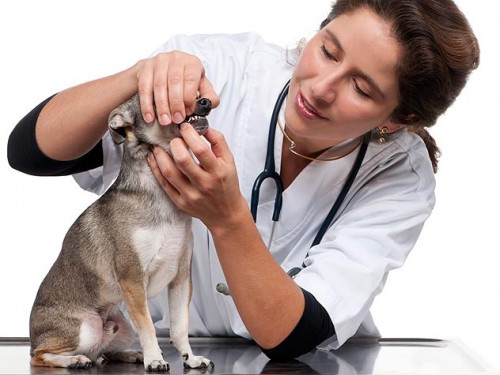
Your veterinarian will run pre-operative bloodwork to make sure your pet is healthy enough to undergo the anesthesia necessary for the procedure. While modern anesthesia is considered very safe, this is a precautionary measure to minimize any risks.
Your veterinarian might take dental radiographs (X-rays) to provide a better evaluation of the health of your pet’s teeth and jaw bone.
During the cleaning, the veterinary team will monitor your pet’s vital signs to ensure that they are normal. These vitals include respiration rate, heart rate, blood oxygen levels and body temperature.
Your pet’s teeth will be cleaned and polished with professional equipment that smoothes the tooth surface, removes tartar and plaque and polishes the teeth.
Antibitoics and/or pain medications may be prescribed depending on the extent of disease at the time of cleaning.
Once the dental cleaning is complete, your pet will be carefully brought out of anesthesia. Your veterinarian will ensure that your pet has recovered properly before releasing him or her to go home. Follow all home care instructions and be sure to check with your veterinarian immediately if you have any concerns.
Home Alone Barking
Within moments of Robin’s departure for work, Ruffles, her scruffy terrier mix, issues his usual succession of short, sharp, assertive barks, consistently apprising Robin’s neighbors of her comings and goings. The co-op board is considering eviction. Robin is at wits’ end.
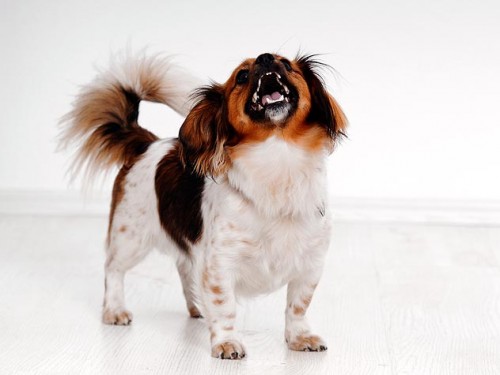
Dogs who bark when left alone fit several profiles. Separation anxiety sufferers are tightly bonded to their guardians and act as though their world has ended when they are apart. These dogs may also eliminate around the home, frantically chew on human possessions, and dig, chew, or propel themselves through doors or windows. To learn more about separation anxiety, refer to Don’t Leave Me This Way.
Some breeds (including most terriers) are born watchdogs, prone to sounding the alarm whenever a noise or movement catches their attention. Elimination of this tendency is unlikely in those born to bark; instead, they must be taught to limit their alerts to five or six barks and then settle down. Confining these “reactive barkers” to a dark, quiet part of the home when you are away promotes sleep instead of constant arousal.
Youngsters of any breed can be vocally challenging, unless exercised to the point of exhaustion. Try waking up early to ensure an hour of romping at the local dog park, throwing a ball until your arm is limp, or dropping Bowser off at doggie day care when morning exercise needs can’t be met.
Finally, there is the barker—like Ruffles—who seems intent on calling the family pack back together. Once family members leave the house, the fun stops. So he offers a vocal locator signal to draw them home. If they return while he’s barking, his efforts are rewarded.
Breaking the Cycle
If owner-absent barkers declare victory every time a family member returns—even if only to holler for quiet—how can this vicious cycle be broken? Start with exercises that reward the dog for being silent. On a day free of work commitments, go through your normal morning routine, but don’t stray far from the door once you’ve left home. If your dog is silent for a predetermined period of time, reenter and reward him. Begin with an easily obtainable goal—say, 10 to 30 seconds. When he barks, set the timer back to zero. It may take awhile to get that first silent success. Some dogs will improve faster when a marker indicates unwanted behavior; a sharp rap on the door with a metal object after a bark may speed things along. No shouting for quiet, though—most dogs prefer negative attention to none at all and may find your hollering rewarding.
Once you have garnered your first success, reenter the home, tell the dog “yes” or “good,” reward him, and go about your business. Keep all comings and goings low-key so he isn’t excessively revved up each time. Repeat the exercise numerous times, lengthening the time away with each success. If you have to restart the count more than a couple of times, you may be moving too far, too fast.
Some dogs will get wise to your presence on the other side of the door. Increase your distance after the first few repetitions to replicate departure. Instead of rapping to mark the unwanted behavior, you could employ a citronella-dispensing collar. This device interrupts each bark with a multi-sensory cue by combining the startling pssst of the mist exploding out of the container, the moist sensation, and the citronella smell. In a 1996 Journal of the American Animal Hospital Association article, Cornell University behaviorists Juarbe- Diaz and Houpt note that the citronella collar is twice as effective (88.9 compared to 44.4 percent) as the electronic shock collar, without the use of a painful stimulus. Some find that the use of the collar alone extinguishes barking proclivities. However, it is not suitable for separation anxiety cases, as these often demand a more extensive behavior modification protocol and possibly drug therapy as well.





